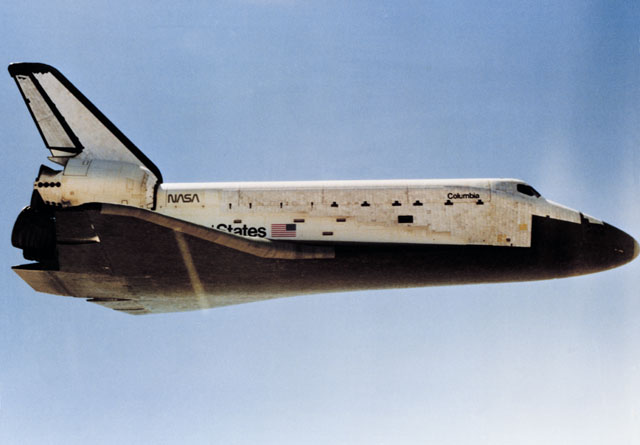
Thirty-five years have now passed since the maiden voyage of the Space Shuttle Program. On the morning of 12 April 1981, orbiter Columbia rocketed away from Pad 39A at the Kennedy Space Center (KSC), kicking off a new era which would see more humans delivered into the heavens than at any other point in history. As described in yesterday’s AmericaSpace article, the two days of STS-1—crewed by Commander John Young and Pilot Bob Crippen—was one of the most hazardous spaceflights of all time, marking the first occasion on which a brand-new spacecraft had undertaken its very first mission with humans aboard. There existed a very real risk that Young and Crippen might lose their lives, not only during launch and ascent, but also during Columbia’s hypersonic re-entry and desert landing at Edwards Air Force Base, Calif. That landing took place on 14 April 1981.
Plunging into the “sensible” atmosphere at Mach 25, subjecting a patchwork of Thermal Protection System (TPS) tiles to extreme re-entry temperatures, and accomplishing an unpowered, “deadstick” touchdown at Edwards were core requirements for the shuttle. Although the last few minutes, from passing subsonic velocity in the low atmosphere to the runway, had been exhaustively rehearsed during Enterprise Approach and Landing Tests (ALTs), the 45 minutes from the “de-orbit” burn of Columbia’s Orbital Maneuvering System (OMS) engines, through the searing furnace of re-entry and the complex series of aerodynamic turns needed to “bleed off” the craft’s speed and align her for touchdown, were largely unknown. To play things safe, NASA opted to use the wide expanse of dry lakebed at Edwards for the first four test flights.
This offered Young and Crippen a somewhat greater margin for error, although it was anticipated that when the shuttle became fully operational and its aerodynamic performance was better understood, precision landings on a narrower concrete runway at KSC would become the norm. Four hours before landing, at around 9 a.m. EDT on 14 April 1981, the two astronauts closed and latched Columbia’s payload bay doors for the final time.
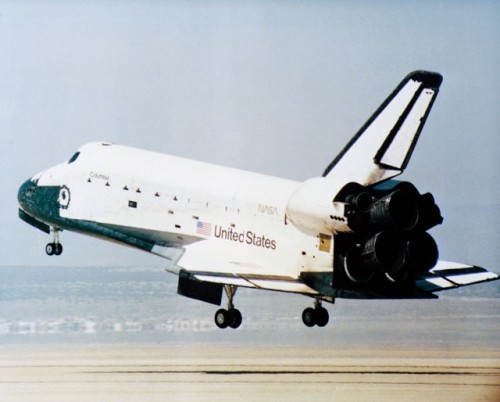
Twenty minutes before the de-orbit burn, they oriented their craft tail-first and switched on two of the three Auxiliary Power Units (APUs). These were responsible for controlling the shuttle’s flight surfaces and hydraulics throughout re-entry. Fifty-three hours and 28 minutes after launch, passing over the Indian Ocean, the OMS engines ignited in the vacuum, slowing Columbia sufficiently to begin her perilous, high-speed glide to a landing strip on the opposite side of the planet. The 2.5-minute burn was reported with typical coolness by Young: “Burn went nominal.”
“Nice and easy does it, John,” replied Capcom Joe Allen from the Mission Control Center (MCC) at the Johnson Space Center (JSC) in Houston, Texas. “We are all riding with you.”
Minutes later, Columbia was turned around and her nose pitched “upward” at a 39-degree angle. Young and Crippen removed the safety pins from their ejection seats and the overhead escape hatches, then switched on the third APU. As the spacecraft entered the denser portion of the atmosphere, the tracking station on the island of Guam in the Central Pacific noted bursts of Columbia’s pulsing thrusters. Traveling at close to 16,000 mph (25,750 km/h), they hurtled onward and onward, as the color of ionized atmospheric gases morphed from a pale pink into a deeper pinkish-red, then reddish-orange, like a blast furnace.
As a tense world waited, the NASA Public Affairs Officer (PAO) reeled off a steady stream of updates. “We will be out of communication with Columbia for approximately 21 minutes,” he noted, making reference to the lengthier-than-normal period of radio blackout, caused by the accumulation of a plasma “sheath” around the orbiter. “No tracking stations before the West Coast … and there is a period of about 16 minutes of aerodynamic re-entry heating that communications are impossible … ” During this time, the Kuiper Airborne Observatory (KAO), flying almost directly beneath Columbia’s path, acquired an infrared image, revealing Columbia’s meteoric descent. The aircraft had earlier taken off from Hickam Air Force Base in Hawaii and established itself at an altitude of 44,880 feet (13,700 meters), about an hour before the spacecraft attained “Entry Interface.”
Descending lower now, the astronauts were, at length, able to receive Ultra-High Frequency (UHF) radio calls, crackling between Mission Control and one of the T-38 Talon chase aircraft which would accompany the shuttle down to the runway. “Hello, Houston,” Young called, “Columbia’s here! We’re doing Mach 10.3 at 188 [thousand feet].” For the majority of this period, except for the so-called “roll reversals”—a series of S-shaped curves to reduce speed—the computers were primarily responsible for flying the vehicle. Shortly after the orbiter crossed the California coastline, near Big Sur, Young took manual control. Long-range tracking cameras on Anderson Peak captured the first ground-based images of Columbia, flying at an altitude of more than 22 miles (35 km).
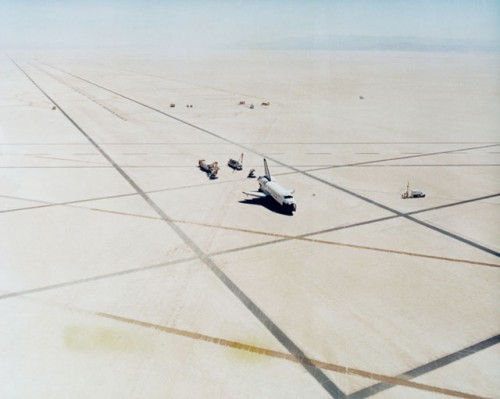
“What a way to come to California!” exulted Crippen.
Still traveling at well over four times the speed of sound, the shuttle passed over Bakersfield, Lake Isabella, and Mojave Airport, enabling the astronauts to verify by glancing through their windows that the ground track was “right on the money.” Young then executed a sweeping, 225-degree turn to align his ship with the dry lakebed Runway 23 at Edwards. Dropping to below 7.5 miles (12 km), he took Columbia’s stick and would later remark that control was crisp and precise.
Watching the arrival of America’s first space shuttle from orbit were tens of thousands of people, including Larry Eichel of the Philadelphia Inquirer. His testimony encapsulated the anxiety of everybody awaiting this historic event. “The shuttle appeared far above the north-east horizon,” he explained, “a white dot against a cloudless blue sky. That dot was dropping so fast that to an eye accustomed to watching the more gradual descent of commercial jets, it seemed inevitable that the shuttle would crash to the desert floor.”
As Columbia drew closer, her speed brake was gradually retracted and was fully closed by the time the vehicle was 2,000 feet (600 meters) above the runway. Falling precipitously, seven times steeper than a commercial airliner, and almost twice the speed, the reaction of Eichel that a crash was about to occur can, perhaps, be forgiven. It was at this point, however, that Young pulled back on the stick, lifted the nose, and transformed his ship, in a split second, from a falling brick into a graceful flying machine.
Weather conditions in the California desert were near-perfect and surface winds were calm. At 10:20:35 a.m. PDT (1:20:35 p.m. EDT), Bob Crippen deployed the landing gear and all six wheels were down and locked into position within the 10-second time limit. Columbia touched down perfectly, 22 seconds later, at a speed of 212 mph (342 km/h), and rolled for almost 9,850 feet (3,000 meters), before coming to a smooth halt. The speed brake was opened and full-down elevons were applied, giving the astronauts an impression of considerable deceleration. “As it touched down,” recalled Eichel, “at a speed 80-90 miles an hour faster than a commercial airliner does, the rear wheels nestled into the hard-packed sand, kicking a rooster-tail high into the air.” The countdown to landing was echoed by both the public affairs spokesmen at Edwards and by the crew of one of the T-38s, who were first to welcome Young and Crippen back home with a resounding “Beautiful! Beautiful!”
Rookie astronaut John Creighton was aboard a U.S. Army helicopter at Edwards that day, and he later described the remarkable efforts of some spectators to get a close-up view of Columbia’s first return from orbit. “All kinds of people had camped out there for several days,” he told the NASA Oral History Project, years later. “There was a fence and there’d been a patrol to keep people back there. As soon as the shuttle rolled to a stop, these people charged forward, [this] fence went down and they got motorcycles and cars that went out racing. This was about five miles from where the shuttle actually landed and the only way you could see was with binoculars, but, boy, they wanted to get an up-front view! The security folks didn’t know what to do, so they told the helicopters to try to get this crowd under control, so these helicopters would swoop down in front of the on-charging group of cars. The helicopter pilots loved it. They were having a great time trying to head off all of these people!”
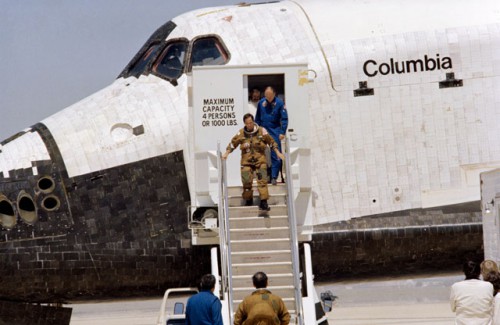
Post-landing analysis revealed that Columbia’s right-hand inboard brakes suffered higher-than-anticipated pressure, which caused a slight tug to the right, just before the wheels stopped. Young compensated for this by balancing the total braking to either side of the shuttle, maintaining a near-perfect course straight down the runway centerline, stopping at the intersection of Runways 23 and 15. One notable surprise was the sheer amount of lakebed debris—pebbles and grains of sand—kicked up by the wheels.
“Do I have to take it to the hangar, Joe?” quipped Young.
“We’re gonna dust it off first,” retorted Joe Allen with a chuckle.
Immediately after wheelstop, the astronauts unstrapped and began safing the OMS and Reaction Control System (RCS) switches before the arrival of the ground crew. When the latter arrived, they first hooked up sensitive “sniffer” devices to verify the absence of toxic or explosive gases and attached coolant and purging lines to Columbia’s aft compartment to air-condition her systems and payload bay and dissipate residual fumes.
Whilst this procedure was underway, the ground teams worked in Self-Contained Atmospheric Protection Ensemble (SCAPE) suits, then moved an airport-type stairway over to the hatch. Years later, Joe Allen would find it amusing to watch Young and Crippen, who looked like ordinary people as they came down the steps … surrounded by the ground team, whose cumbersome SCAPE suits made them look like the astronauts!
John Young, who had remained totally cool throughout re-entry, now let his excitement get the better of him. As soon as he got outside, about an hour after touchdown, he bounded down the steps, checked out the tires and landing gear, and jabbed the air triumphantly with both fists. He even kicked the tires, which scared the life out of the engineers, because they contained 375 psi of pressure. Combined with the hot brakes, there existed a real possibility that a tire might explode. Young, of course, could be forgiven. He was over-excited after completing the most audacious flying challenge of his career.
And it showed.
“I’ve often claimed that John calmed down” by the time he got outside, Bob Crippen said later, but noted with a twinkle in his eye: “You should’ve seen him when he was inside the cockpit!”
This is part of a series of history articles, which will appear each weekend, barring any major news stories. Next week’s article will focus on the 15th anniversary of STS-100, which delivered and activated Canadarm2—the International Space Station’s “Big Arm”—and featured the first-ever spacewalk by a Canadian citizen.
Want to keep up-to-date with all things space? Be sure to “Like” AmericaSpace on Facebook and follow us on Twitter: @AmericaSpace





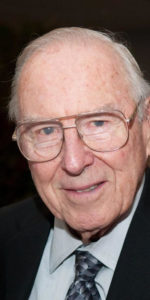
One Comment
One Ping
Pingback:Astronaut Scholarship Foundation to Honor 35th Anniversary of First Shuttle Missions « AmericaSpace